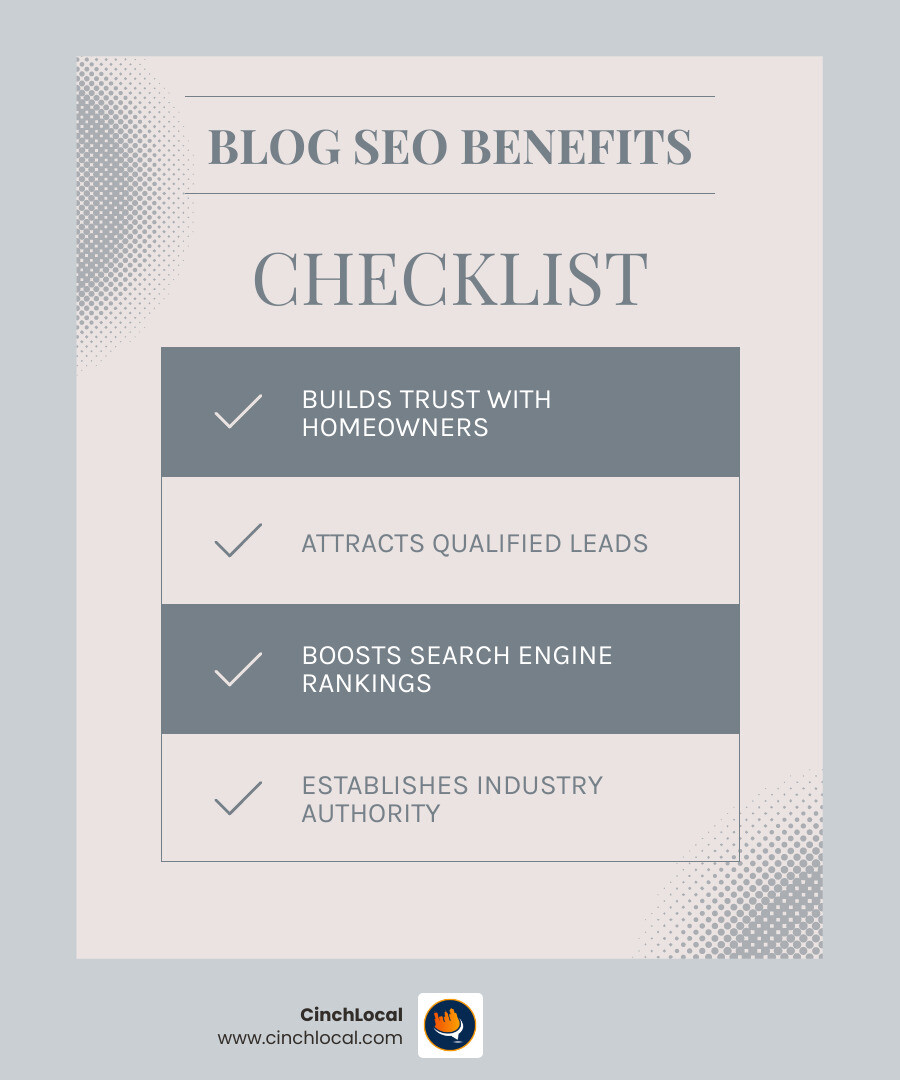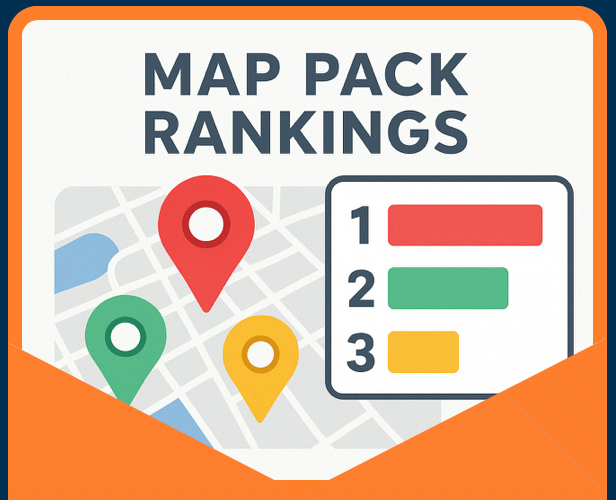
Cary Byrd // Founder of CinchLocal
From Zero to Hero: Elevate Your Blog with Smart SEO
Open uping Growth: The Power of Blog SEO for Roofers

For roofing contractors, mastering blog SEO is essential for attracting local homeowners and growing your customer base. It's a powerful component of any modern roofing marketing plan that turns your website into a lead-generating machine. This guide explains how to implement a roofing SEO strategy that drives real business growth.
Blog SEO is the process of optimizing your blog content to rank higher in search engines. This involves keyword research, on-page optimization, ensuring technical health, and building links. The goal is to achieve more visibility, generate qualified leads, and establish your company as a local authority.
Why is this critical? Because 56% of consumers report making a purchase after reading a company's blog. Your blog answers homeowner questions, builds trust, and positions you as the go-to expert. It ensures you're the first roofer they find when they need help most.
I'm Cary Byrd, leader of CinchLocal. With over a decade of digital marketing experience, I've distilled the most effective blog SEO and digital strategies into this practical guide.

The Blueprint: Building Your Blog SEO Foundation
A successful roofing blog requires a solid plan, not random posts. It's about understanding your customer's problems and structuring your content to provide valuable answers. Think of it as building a solid framework before laying the shingles.
Identifying Your Ideal Customer & Their Questions
Before writing, you must know who you're writing for. Are you targeting first-time homeowners worried about a leak, or commercial property managers needing a maintenance partner? Creating buyer personas helps you get inside their heads.
Homeowners might Google "signs of roof damage after storm," while property managers search for "commercial roofing maintenance schedule." Understanding this search intent is crucial. Your blog needs to address both informational queries (gathering information) and transactional queries (ready to hire). By consistently answering their real questions, you build trust long before the first phone call. For content ideas, our guide on Creative Roofing Blog Ideas for Roofers can help you brainstorm topics that resonate locally.
Keyword Research for Roofers: Finding Your Goldmines
Keyword research is the process of finding the exact terms your customers use on Google. These are your goldmines for attracting qualified traffic.

- Long-tail keywords: Focus on specific phrases like "how much does emergency roof repair cost." These searches have lower volume but higher intent, making them easier to rank for and more likely to convert.
- Local SEO keywords: As a contractor, your focus is local. Terms like "roof repair [your city]" or "emergency roofer near me" connect you directly with customers in your service area.
- Question-based keywords: Tools like Answer The Public reveal the exact questions people ask Google, such as "How long does a metal roof last?" Answering these thoroughly can land you in Google's featured snippets.
Structuring for Success: Subfolders, Not Subdomains
Where your blog lives on your website has a massive impact on SEO. Always use a subfolder ( yourroofingco.com/blog
) instead of a subdomain ( blog.yourroofingco.com
).
Search engines treat subdomains as separate websites. This means any SEO authority your blog earns—backlinks, trust signals, ranking power—doesn't fully benefit your main site. A subfolder, however, is part of your main site, so all the authority your blog builds strengthens your entire domain. Marketing expert John Doherty documented a case where moving a blog from a subdomain to a subfolder resulted in a 98% traffic increase. This simple structural change is a foundational decision that pays dividends for years.
On-Page Blog SEO: Optimizing Every Post for Maximum Impact
With the foundation in place, it's time to optimize each blog post. These practical techniques tell Google what your content is about and why it deserves to rank for roofing queries.
Writing Content That Ranks and Converts
The goal is to write content that resonates with homeowners and drives them to choose your services. This requires a focus on quality, authority, and clarity.

Google prioritizes content that demonstrates E-E-A-T —Experience, Expertise, Authoritativeness, and Trustworthiness. As a roofer, your real-world experience is your greatest asset. Share case studies, before-and-after photos, and insights from your projects. This authenticity builds credibility with both search engines and clients.
Your content must also be readable and comprehensive. Use short sentences, clear paragraphs, and avoid industry jargon. The goal is not to hit a specific word count, but to completely answer the user's question. A thorough post keeps visitors on your page longer, sending positive signals to Google. As we've seen firsthand, Does Blogging Really Help Roofer SEO? The answer is a definitive yes when you create helpful, reliable, and people-first content.
Mastering On-Page Elements for blog SEO
Every element on your page is an optimization opportunity.
- Title Tag: The clickable headline in search results. Keep it under 60 characters and include your primary keyword near the beginning.
- Meta Description: The summary below the title. While not a direct ranking factor, a compelling description (around 300 characters) boosts your click-through rate.
- Header Tags (H1, H2, H3): These structure your content for users and search engines. Your H1 is the main title, while H2s and H3s break up the text into scannable sections.
- URL Optimization:
Keep URLs short, descriptive, and include the primary keyword (e.g.,
yourroofingco.com/blog/emergency-roof-repair). - Keyword Placement: Integrate keywords naturally in your intro, conclusion, and headers. Avoid bad practices like keyword stuffing , which will harm your rankings.
The Power of Visuals and Internal Links
Visuals and internal links keep visitors engaged and help search engines understand your site's structure.
Image optimization
is crucial. Use high-quality, compressed images of your work. Use descriptive file names ( hail-damage-roof-repair.jpg
) and add alt text
that describes the image for accessibility and SEO. Properly optimized images can even rank in Google Images.
An internal linking strategy connects your content, distributing authority and guiding users to more relevant information. For example, a post on roofing materials should link to your posts on shingle installation or metal roofing benefits. Use descriptive anchor text that tells users what to expect. For instance, linking to a guide on content marketing strategies for roofers is much more effective than using generic text like "click here." This creates a robust content network that boosts engagement and rankings.
Technical SEO & Promotion: Getting Your Content Seen
Writing a great post is only half the battle. To ensure your content reaches potential roofing clients, you must focus on your blog's technical health and promotion strategy.
Speed and Mobile: The Non-Negotiables of Modern SEO
A slow or non-mobile-friendly website is a lead-killer. These are critical ranking factors that directly impact your blog SEO performance.

Page speed is paramount. Homeowners won't wait for a slow page to load; they'll call your competitor. Google knows this and ranks fast-loading sites higher. Furthermore, with over half of searches happening on mobile, Google uses mobile-first indexing . Your blog must be mobile-responsive and provide an excellent experience on smartphones.
Google's Core Web Vitals measure user experience factors like load time and interactivity. Use Google's mobile site speed test to diagnose issues before they cost you leads.
Beyond Publishing: Promoting Your Content
Hitting 'publish' is the starting gun, not the finish line. Active promotion is necessary to reach homeowners.
- Social Media: Share posts on Facebook, Instagram (for project photos), and LinkedIn (for commercial clients). Engage with your audience by asking questions and responding to comments.
- Email Newsletter: Send new content to past clients and leads. This reinforces your expertise and keeps your company top-of-mind for referrals.
- Local Forums: Answer questions in community groups with a link to your relevant blog post. Provide value, don't just self-promote.
- Content Repurposing: Turn one blog post into multiple pieces of content, like social media graphics or short videos. This extends your reach exponentially. A consistent promotion strategy is highly effective; we've seen it triple our clients' leads in just 5 weeks.
Measuring Success with Google Search Console
You can't improve what you don't measure. Google Search Console (GSC) is a free tool that provides invaluable data on your blog's performance.
The performance report shows which queries bring users to your site, your average ranking, and your click-through rate (CTR). This data reveals what's working. A low CTR, for example, suggests your title tag or meta description needs to be more compelling.
The index coverage report alerts you to any issues preventing your pages from appearing in search. Use the URL Inspection Tool to see how Google views a specific page and troubleshoot problems. By monitoring these metrics, you can make data-driven decisions to refine your blog SEO strategy and generate more leads.
The Future of Blog SEO: AI and Advanced Tactics
The world of SEO never stands still. Staying ahead means understanding where search is headed. This section explores emerging trends like AI and advanced tactics like historical optimization to keep your roofing blog generating leads.
Adapting Your blog SEO for AI Search
The way people find information is changing. With AI search traffic projected to overtake traditional search by 2028, your blog SEO strategy must evolve.
People are now having conversations with search engines, asking questions like, "What should I do about water stains on my ceiling?" Google's AI Overviews provide direct answers at the top of the results. To become the source for these answers, you must accept conversational keywords and provide direct answers early in your posts. Answer the question clearly in the first paragraph, then expand with details. Your real-world roofing expertise is exactly what AI systems are designed to reward. For more on this, see our guide on how to Unlock Your Inner Blogger: Writing Posts with AI.
Winning SERP Features: Featured Snippets and Rich Results
Featured snippets , or "position zero," are the boxed answers that appear above all other search results. They offer incredible visibility. You can capture these by structuring your content to concisely answer common questions (in 40-60 words) and using formats like how-to lists.
Rich results are visually improved listings with elements like star ratings or images. We achieve this by implementing structured data , which is code that helps search engines understand your content. Using schema for FAQs or articles makes your listings more prominent and clickable.
The Power of Historical Optimization
Your best blog post from two years ago could be a missed opportunity today. Historical optimization is the cost-effective strategy of refreshing and improving existing content.
Even top-performing articles suffer from content decay as information becomes outdated. Instead of letting them fade, we identify and update these posts. This involves updating statistics (e.g., roof replacement costs), adding new information, and re-optimizing for current keywords. We also prune or consolidate outdated content that could harm your site's authority. Refreshing existing content often delivers faster results than creating new posts from scratch because you're building on established authority.
Frequently Asked Questions about Blog SEO for Roofers
How long does it take for blog SEO to work for my roofing company?
Blog SEO is a long-term investment. It typically takes 3-6 months of consistent effort to see significant movement in search rankings and an increase in qualified leads. The timeline can be shorter in less competitive local markets. The key is that each post you publish builds on the last, creating a content library that works for your business 24/7.
How often should I post on my roofing blog?
Consistency is more important than frequency. Aim for 1-4 high-quality, comprehensive posts per month. A single, well-researched article that thoroughly answers a customer's question is far more valuable than multiple thin, rushed posts. Quality over quantity always wins in the long game of blog SEO.
Can I just use AI to write all my blog posts?
AI is a useful assistant for brainstorming and drafting, but it cannot replace your human expertise. In a trust-based field like roofing, your real-world experience is what creates content that demonstrates E-E-A-T (Experience, Expertise, Authoritativeness, and Trustworthiness). An AI can't share a story about a tricky repair or explain what hail damage truly looks like. Use AI as a tool to improve your unique voice and knowledge, not as a replacement for it.
Conclusion
Mastering blog SEO is about building genuine relationships with homeowners who need your expertise. By consistently answering their questions and showcasing your experience, your blog becomes a powerful asset that generates leads for your roofing business for years to come.
This strategic approach—from customer identification to technical optimization—builds trust, attracts qualified leads, and establishes your authority. We've seen it work for roofing contractors across Ohio, Tennessee, Georgia, California, and throughout the USA.
However, implementing a winning blog SEO strategy takes time and consistent effort that many roofers don't have.
That's why we created CinchLocal's Roofer Footprint Expansion System. We specialize exclusively in the roofing industry, and our proven system is designed to help you dominate your local market. We handle the strategy, content, and optimization so you can focus on what you do best: delivering exceptional roofing services.
If you're ready to turn your blog into the lead-generation powerhouse it should be, discover how our Roofer Footprint Expansion System can help you dominate your local market. Let's build something remarkable together.
Want Us to Uncover Hidden 'Footprint Gaps' And Critical Blind Spots That’s Quietly Draining Calls, Jobs, and Profits?
Simply Fill Out The Form Below:







